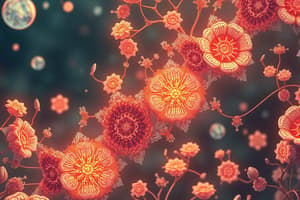Podcast
Questions and Answers
Which generation of quinolones has a basic piperazino group at C-7 and a fluorine atom at C-6?
Which generation of quinolones has a basic piperazino group at C-7 and a fluorine atom at C-6?
- Second generation (correct)
- First generation
- Fourth generation
- Third generation
What is the main characteristic of the first generation quinolones?
What is the main characteristic of the first generation quinolones?
- Narrow spectrum (Gram-negative bacteria) (correct)
- Broad spectrum (Gram-negative and Gram-positive bacteria)
- Long-lasting pharmacokinetic properties
- Effective against complicated urinary tract infections
Which ring is common to all quinolones?
Which ring is common to all quinolones?
- N1-alkylated-3-carboxypyrid-4-one ring (correct)
- N1-alkylated-3-carboxypyrid-5-one ring
- N1-alkylated-3-carboxypyrid-6-one ring
- N1-alkylated-3-carboxypyrid-2-one ring
What is the therapeutic use of the first generation quinolones?
What is the therapeutic use of the first generation quinolones?
Which generation of quinolones has a wider spectrum of action, including Gram-negative bacteria and Staphylococci?
Which generation of quinolones has a wider spectrum of action, including Gram-negative bacteria and Staphylococci?
Flashcards are hidden until you start studying
Study Notes
Quinolones
- The second generation of quinolones has a basic piperazino group at C-7 and a fluorine atom at C-6.
- The main characteristic of the first generation quinolones is the narrow spectrum of antibacterial activity.
- The 4-quinolone ring is common to all quinolones.
- The first generation quinolones are used to treat urinary tract infections (UTIs) and other Gram-negative bacterial infections.
- The second generation of quinolones has a wider spectrum of action, including Gram-negative bacteria and Staphylococci.
Studying That Suits You
Use AI to generate personalized quizzes and flashcards to suit your learning preferences.



